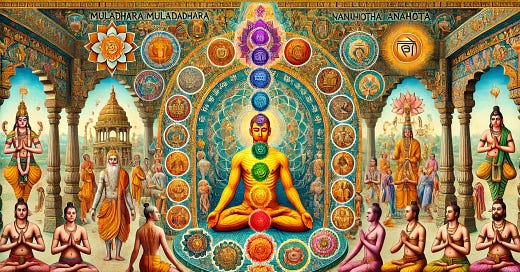Vedic Traditions: The Vital Life Force of Prana
From the sands of Egypt, Dr. Elara Magnus’s journey into the history of bioelectric fields transitions to the ancient Indian subcontinent. Here, she delves into the rich and profound Vedic traditions. The Vedas, among the oldest sacred texts known to humanity, offer a detailed understanding of "Prana"—the vital life force that flows through all living beings. Through meticulous research, Dr. Magnus explores how the practices of yoga and pranayama (breath control) were designed to harness and manipulate this energy, fostering both physical health and spiritual well-being.
The Concept of Prana
In Vedic philosophy, Prana is considered the universal life force that animates and sustains the universe. It is the breath of life, an essential energy that pervades all forms of existence. According to the Vedas, Prana flows through the body in channels known as nadis, intersecting at various points called chakras, which are centers of vital energy.
Dr. Magnus’s research highlights that the ancient sages believed in the five primary forms of Prana, each governing different functions in the body:
Prana: Responsible for respiration and the inhalation of energy.
Apana: Governs elimination and downward energy flow.
Samana: Manages digestion and assimilation of nutrients.
Udana: Controls sound production and upward energy flow.
Vyana: Distributes energy throughout the body.
These distinctions illustrate a sophisticated understanding of bioelectric phenomena, with each type of Prana representing different aspects of life’s energetic processes.
Yoga: The Path to Harnessing Prana
Yoga, a practice deeply embedded in Vedic traditions, is more than physical postures; it is a holistic discipline designed to align the body, mind, and spirit. Dr. Magnus’s studies reveal how yoga serves as a comprehensive system to balance and enhance the flow of Prana.
Asanas (Postures): Asanas are physical postures that facilitate the free flow of Prana through the nadis. Each posture is designed to open and energize specific parts of the body, removing blockages and ensuring a harmonious distribution of life force. Dr. Magnus notes that the practice of asanas helps in grounding Prana, stabilizing it within the body, and preparing the practitioner for deeper energetic work.
Pranayama (Breath Control): Pranayama, the practice of breath control, is a cornerstone of yoga, directly concerned with the regulation of Prana. Techniques such as Nadi Shodhana (alternate nostril breathing), Kapalabhati (skull shining breath), and Bhramari (bee breath) are employed to cleanse the nadis and enhance the flow of Prana.
Dr. Magnus highlights that pranayama practices are meticulously structured to influence the different types of Prana, ensuring their proper balance and functioning. By mastering pranayama, practitioners can increase their vitality, mental clarity, and spiritual awareness, effectively harnessing the bioelectric field for health and well-being.
Meditation and Mantras: Meditation and the use of mantras are integral to the Vedic tradition, serving as tools to focus and direct Prana. Through meditation, practitioners can cultivate an awareness of Prana’s subtle movements, achieving deeper states of consciousness and energetic balance.
Mantras, sacred sounds or phrases, are believed to carry vibrational energies that resonate with different aspects of Prana. Dr. Magnus’s research shows that the repetitive chanting of mantras can create specific energetic patterns, aligning the practitioner’s bioelectric field with higher states of spiritual consciousness.
The Chakra System
Central to the Vedic understanding of Prana is the chakra system, which maps out the body’s energy centers. Dr. Magnus’s exploration into this system reveals how each chakra corresponds to different physiological and psychological functions, as well as spiritual potentials.
The seven primary chakras are:
Muladhara (Root Chakra): Grounding and survival instincts.
Swadhisthana (Sacral Chakra): Creativity and emotional balance.
Manipura (Solar Plexus Chakra): Personal power and self-esteem.
Anahata (Heart Chakra): Love and compassion.
Vishuddha (Throat Chakra): Communication and self-expression.
Ajna (Third Eye Chakra): Intuition and insight.
Sahasrara (Crown Chakra): Spiritual connection and enlightenment.
Dr. Magnus illustrates how the proper flow of Prana through these chakras is crucial for maintaining overall health and achieving spiritual growth. Practices like yoga, pranayama, and meditation are designed to cleanse, activate, and balance these energy centers, ensuring the harmonious flow of bioelectric energy.
Conclusion
Dr. Elara Magnus’s exploration of Vedic traditions uncovers a profound and sophisticated understanding of Prana, the vital life force. The Vedas, through their teachings on yoga, pranayama, and the chakra system, offer a holistic approach to health and spirituality, emphasizing the interconnectedness of body, mind, and spirit.
By studying these ancient practices, Dr. Magnus bridges the gap between past and present, showing how the manipulation of bioelectric energy through traditional methods can lead to enhanced well-being and spiritual enlightenment. The Vedic traditions, with their deep insights into the nature of Prana, continue to inspire and inform modern explorations into the mysteries of life’s vital forces.




